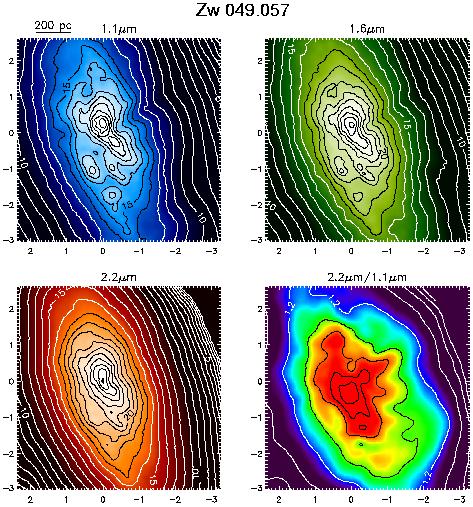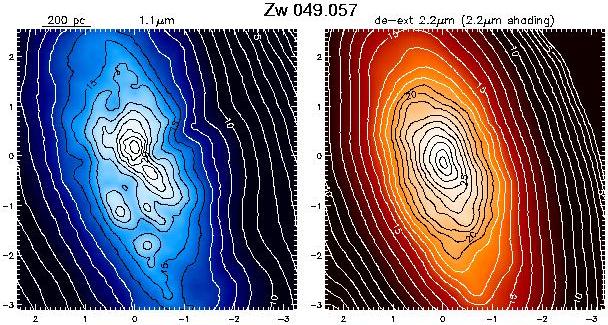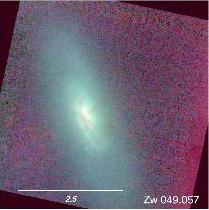


Zw049.057 appears as a highly inclined disk with a
smooth light distribution at large radii but a bright arm of star
formation ~ 1" south of the 2.2 µm peak. The reddening and
the extinction-corrected 2.2 µm
emission also peak ~ 0.5" south of the 2.2 µm emission
peak. Zw049.057 exhibits a linear
`shadow' feature extending radially from the nucleus along the minor axis
at PA
Shaded contour plots of the extinction corrected
2.2 µm emission are shown together with the 1.1
µm (upper left)
observed emission. In both panels, the contours and shading are
logarithmic with the contours spaced by factors 21/2. (The level
values are the same as for the figure above). The arcsec displacements
in RA and DEC, given along the borders are measured from the 2.2
µm in
all frames. At the upper left, a length bar is drawn. For the ratio image,
both the 2.2 and 1.1 µm images were smoothed with the same adaptive
smoothing and then smoothed with a Gaussian FWHM = 0.2" in
calculating the 2.2 µm opacity from Eq. 3 (see text). In
cases where a
strong point-source or variable background contaminated the 2.2 µm
image, the extinction corrected image was derived for 1.6
µm. For the
galaxies with strong point-sources, the PSF was fit to the source and then
subtracted and replaced by a Gaussian with the proper integrated flux (see
text - NGC 7469, IRAS 08572+3915, IRAS 05189-2524, PKS 1345+12, IRAS 07598+6508, Mrk 1014 and 3C48).

 -50°. The feature
is perhaps due
to an absorbing cloud in the nucleus blocking radiation along the shadow
line on the minor axis. This interpretation would imply that much of the
light seen along the minor axis of the galaxy is scattered light from the
nucleus. Alternatively, if this is a dust absorption lane, it must extend
linearly over 500 pc in radius and a high mass is required in order
to produce the absorption over the extent of the lane.
-50°. The feature
is perhaps due
to an absorbing cloud in the nucleus blocking radiation along the shadow
line on the minor axis. This interpretation would imply that much of the
light seen along the minor axis of the galaxy is scattered light from the
nucleus. Alternatively, if this is a dust absorption lane, it must extend
linearly over 500 pc in radius and a high mass is required in order
to produce the absorption over the extent of the lane.

